Nochmal eine Tribute-Arbeit, wieder ein Modell nach einem CG-Vorbild von SPINNERS auf whatifmodelers.com:
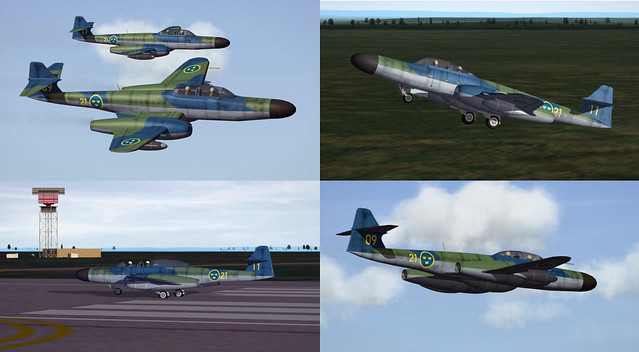
Mehr dazu hier:
http://www.whatifmodelers.com/index.php/topic,18821.1485.htmlIch fand die Anstrich/flugzeug-Kombo so überzeugend, dass ich zur Tats schritt... zumal ich ein passendes Modell "auf Halde" hatte.

Und so wurde der "rore Niklas" geboren:


Some background:The Gloster Meteor was the first British jet fighter and the Allies' first operational jet aircraft during the Second World War. The Meteor's development was heavily reliant on its ground-breaking turbojet engines, pioneered by Sir Frank Whittle and his company, Power Jets Ltd. Development of the aircraft itself began in 1940, although work on the engines had been underway since 1936. The Meteor first flew in 1943 and commenced operations in 1944 with the RAF.


Several major variants of the Meteor incorporated technological advances during the 1940s and 1950s. In order to replace the increasingly-obsolete de Havilland Mosquito as a night fighter, the Meteor was adapted to serve in the role as an interim aircraft. The new night fighter was designed to specification F.24/48 for a two seat, twin-engine, night fighter capable of intercepting contemporary bombers.
Gloster had initially proposed a night fighter design to meet the Air Ministry specification for the Mosquito replacement, based on the two-seater trainer variant of the Meteor, with the pilot in the front seat and the navigator in the rear. Once accepted however, work on the project was swiftly transferred to Armstrong Whitworth to perform both the detailed design process and production of the type; the first prototype flew on 31 May 1950.
Although based on the T.7 twin-seater, the night fighter used the fuselage and tail of the F.8 and the longer wings of the F.3. An extended nose contained the AI Mk 10 Air Intercept radar (the 1940s Westinghouse SCR-720). As a consequence the 20 mm cannons had to be moved from the fuselage flanks into the wings, outboard of the engines. A ventral fuel tank and wing mounted drop tanks completed the Armstrong Whitworth Meteor NF.11.
As radar technology developed, a new Meteor night fighter was developed to use the improved US-built APS-21 system. The NF.12 first flew on 21 April 1953. It was similar to the NF 11 but had a nose section 17 inches (43.2 cm) longer; the fin was enlarged to compensate for the greater keel area of the enlarged nose and to counter the airframe reaction to the "wig-wag" scan of the radar which affected the gunsight.


An anti-tramp motor operating on the rudder was fitted midway up the front leading edge of the fin. The NF.12 also had the new Rolls-Royce Derwent 9 engines and the wings were reinforced to handle the new engine. Deliveries of the NF.12 started in 1953, with the type entering squadron service in early 1954. The NF.12 was also exported, e. g. to Belgium, France or Denmark. In RAF service, however, the type was already replaced over 1958–59.
The final Meteor night fighter was the NF.14 (The NF.13 was a tropicalized variant of the NF.11, which served in Egypt, Syria and Israel). First flown on 23 October 1953, the NF.14 was based on the NF.12 but had an even longer nose, extended by a further 17 inches to accommodate new equipment, and a larger bubble canopy to replace the framed T.7 version.



Just 100 NF.14s were built; they first entered service in February 1954 beginning with RAF No. 25 Squadron and were being gradually replaced as early as 1956 with the Gloster Javelin. Overseas, they remained in service a little longer, serving with No. 60 Squadron at Tengah, Singapore, until 1961.
With only few flying hours on the clock several NF.14 were earmarked for being revamped and offered for export. 14 of these aircraft stayed in the UK, though, and were converted to training aircraft as NF(T).14 and given to No. 2 Air Navigation School on RAF Thorney Island where they served until 1965.


But some of the young NF.14s In 1955 Sweden ordered 22 of these surplus machines as replacement for its obsolete J30 (Mosquito NF.30) fleet that had entered service in 1948 and which was already due to be phased out. The Meteors were allocated only intended to act as stopgaps, though, just as in RAF service, while the Saab J32 Lansen (specifically its dedicated, radar-equipped all-weather fighter variant ‘B’) was still under development.
The batch of revamped Meteor NF.14s was gradually delivered and allocated to F 17 at Kallinge and F 21 at Luleå, starting in late 1956 when the first retired RAF aircraft trickled back to Armstrong Whitworth, and the last one was handed over to the Flygvapnet in mid-1957. In Swedish service the Meteor NF.14 received the domestic designation J31 (‘Jakt’). The machines differed only slightly from the RAF NF.14, main armament remained the four 20mm cannons in the wings. The external tanks were kept, too, in order to provide a sufficient range for patrol flights.


The J31s career was short and unspectacular, though. When the J32B finally reached the fighter units in 1958, the Swedish Meteors were gradually replaced and retired. Six machines were kept for radar operator training, and in this second line role six machines eventually served until 1965.
Strangely, none of the Swedish J31 Meteors were converted to target tugs. Instead Sweden bought several retired Meteors (T.7 and NF.11) from Denmark and used these aircraft with civil registrations through Svenska Flygtjanst as target tugs.

General characteristics: Crew: 2
Length: Length: 51 ft 4 in (15.65 m)
Wingspan: Span: 43ft
Height: 13 ft 11 in (4.2 m)
Wing area: 350 ft² (32.52 m²)
Empty weight: 12.620 lb (5.725 kg)
Loaded weight: 21.200 lb (9.625 kg)
Powerplant: 2× Rolls-Royce Derwent 9 engines, rated at 3.800lb/16,9kN each
Performance: Maximum speed: 585mph (511 knots, 942 km/h, Mach 0.

at 10.000 ft (3.050 m)
Range: 875 mi (765 nmi, 1.408 km)
Service ceiling: 43,000 ft (13,100 m)
Rate of climb: 5,800ft/min at sea level
Wing loading: 44.9 lb/ft² (218.97 kg/m²)
Thrust/weight: 0.45
Armament: 4× 20 mm British Hispano Mk. V cannons in the outer wings
Die Basis ist der A.W. Metor NF.11/12/14 Bausatz von Matchbox (wurde auch von Revell vertrieben und lebt aktuell als Xtrakit-Bausatz von Hannants weiter), der praktisch OOB gebaut wurde. das Ding ist simpel, Passform ist bestenfalls Durchschnitt, es gibt viel zu spachteln. Das Cockpit ist für Pygmäen (die Piloten in den Bildern sind HO und nur fürs Shooting reingesetzt), und beim Fahrwerk darf man rätseln, wie es eigentlich montoert werden soll...
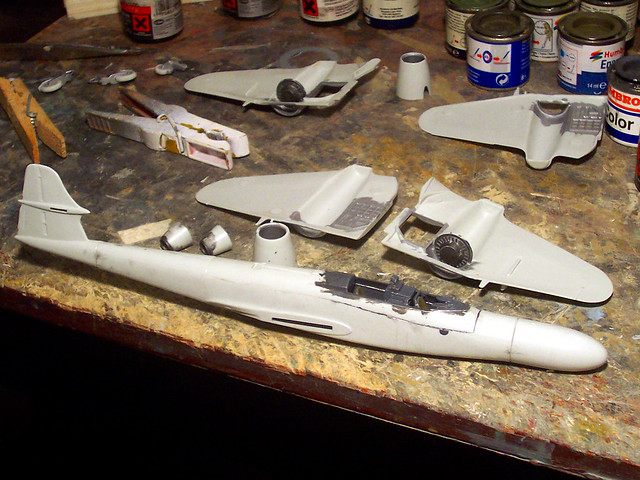


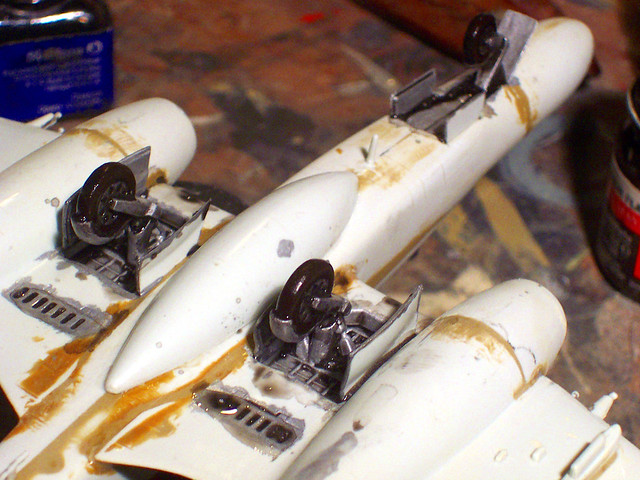
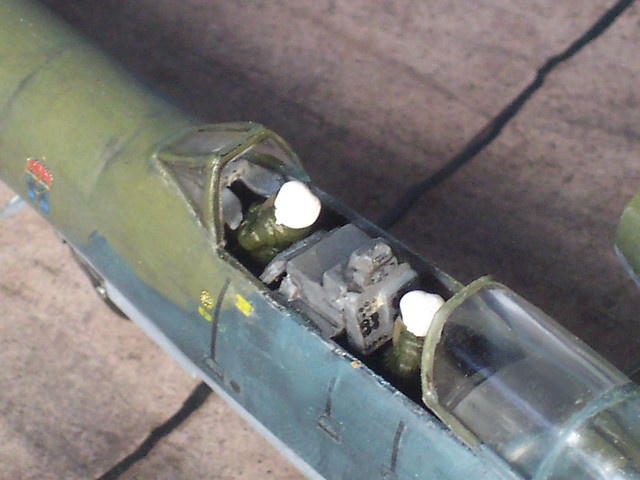
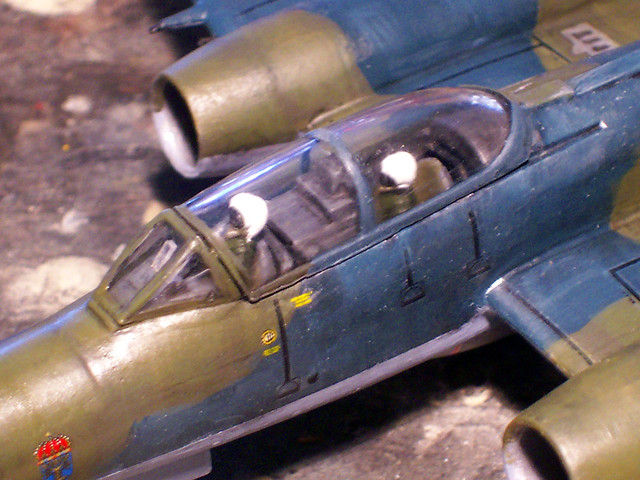
Die Bezeichnung "J31" ist ein Doppler, denn die 31 war für Spitfire PR.19 Fotoaufklärer in Benutzung - allerdings als S31 (Spaning), so dass das J (Jakt) frei war.

Der Anstrich ist ebenfalls "klassisch", aber das "mörk olivgrön/mörkblå/blågrå" Schema hat seine Tücken, denn es gibt kaum verlässliche Farbangaben. Besonders das Blau verwitterte ganz schnell und übel bis zum Türkis, und auch das Grün konnte bis ins Khakifarbene ausbleichen. FS 36173 von unten ist authentisch (anhand von Museumsmaschinen), aber am Modell viel zu dunkel, so dass auch hierbei improvisiert wurde.
Ich bin bei Humbrol 163 (Extra Dark Slate Grey) und 77 (Navy Blue) gelandet, später wurde mit Trockenbemalung ordentlich aufgehellt. Untenrum bin ich bei "Italian Light Blue Grey" von Modelmaster gelandet. Das Schema selber stammt von einer späten J32 Lansen.

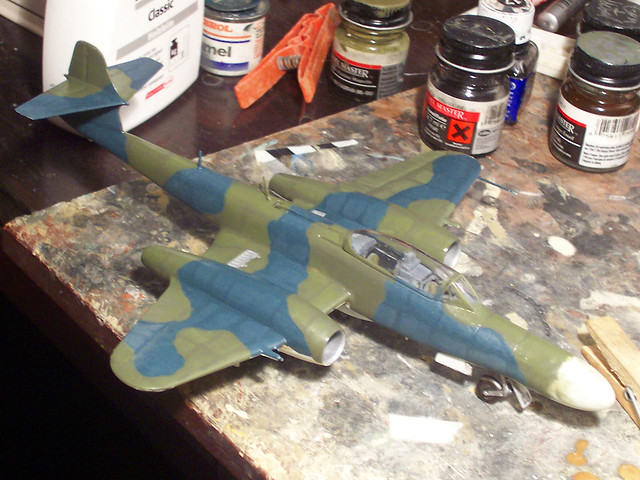
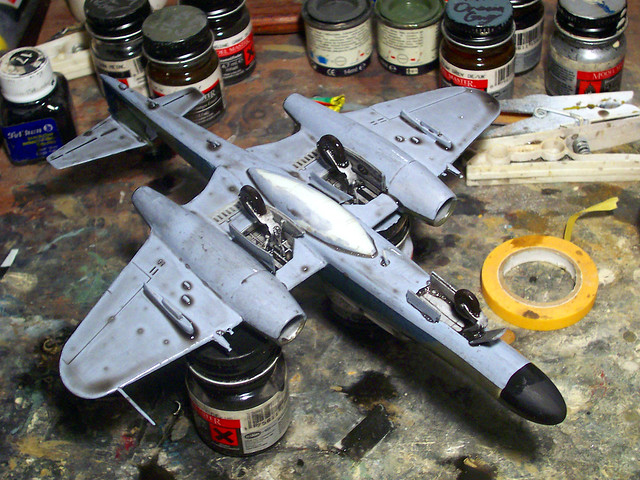

Hoheitsabzeichen und takt. Codes stammen von einem RBD Decal-Sheet aus Schweden, die Warnhinweise etc. kommen vom Matchbox-Sheet. Das rote Band am Radom ist eine eigene Ergänzung, aus der Zeit als es noch farbige Codebuchstaben statt Ziffern gab (umstellung um 1960); die Farbe bezeichnete die Gruppe innerhalb der Staffel (Rot = 1., Gelb = 2., Blau = 3.).



Im Prinzip also was Einfaches, ohne größere chirurgische Eingriffe - aber der Meteor-Nachtjäger als Schwede sieht unglaublich plausibel aus.
